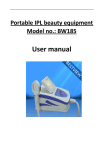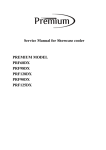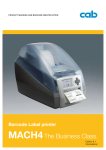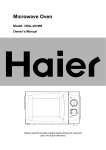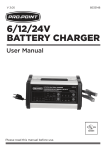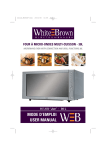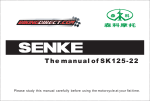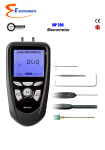Download Installation and Operation Manual
Transcript
Semi-hermetic Scroll Refrigerant Compressor Installation and Operation Manual ChynTec International Co., Ltd Mar. 2008 Table of Contents I. EXTERIOR ------------------------------------- 2 II. UNPACKING ------------------------------------- 3 III. INSTALLATION ------------------------------------- 5 IV. PIPING/WIRING ------------------------------------- 7 V. ------------------------------------- 9 OPERATION NOTICE VI. ACCESSORY LIST ------------------------------------- 11 Semi-hermetic Scroll Refrigerant Compressor 1 I. EXTERIOR Lifting Hanger (Eyebolt) Outlet Flange Nameplate Intake Flange Terminal Box Stand Oil Heater 1/4” NPT Non-Return Connection Note: Pressure measured here is the oil pressure, not the refrigerant pressure at lower pressure side. DO NOT charge liquid refrigerant here. Sight Glass (Take caution when oil level below 1/4 during operation) Oil Return Connection (1/4” Flare) Oil Drain (3/8” Flare Connection) 2 II. UNPACKING 1. Check if there is any exterior flaw and damage to compressor during transportation. 2. Check all specifications on nameplate. 3. Accessory Kit Package: 1. Anchor Bolt 2. Nut 3. Washer 4. Robber Isolator ○ 5. Robber Isolator □ 6. Intake Gasket 7. Outlet Gasket 8. Spring Washer (for intake flange) 9. Spring Washer (for outlet flange) x4 x4 x8 x8 x4 x1 x1 MP15 Gasket x4 x4 Spring Washer Anchor Bolt □ Robber Isolators 3 ○ Robber Isolators 4. Check the amount of anchor bolts. Washer x2 Nut x1 ○ Robber Isolator x2 □ Robber Isolator x1 (M10) Anchor Bolt x1 (M10) 【Accessory for each anchor bolt】 5. Screw on lifting hanger (eyebolt) for lifting compressor. Hanger Bolt Hole 6. Always use eyebolt to lift the compressor. 4 Screw on eyebolt III. INSTALLATION Nut 1. Install standard anchor bolts and rubber isolators ○ Robber Isolator x1 Before screwing on anchor bolts, please align the robber isolators and bolt holes of compressor stand to prevent from reducing the vibration absorbability of isolators. □ Robber Isolator x1 ○ Robber Isolator x1 2. Remove Intake/Outlet Flange Bolt (M10) Washer x 1 Compressor Stand System Frame Washer x1 Outlet Flange Unscrew gently to release interior high pressure nitrogen before removing the baffle board. Intake Flange Outlet Baffle 5 3. Remove old gasket and install new gasket Outlet Flange MP15 Gasket Before brazing brass pipe onto flange, please remove flange first. DO Assemble NOT proceed with brazing spring process when the flange washer is installed on with bolt compressor. After brazing, take the new intake/outlet gasket (MP15) from Accessory Kit Package for installation. Use spring washer and screw to tighten intake/outlet flange. Recommended flange tightening torque: 80 N-m. Bolt for outlet flange Outlet Flange and Gasket (MP15) installation MP15 Gasket Intake Flange Assemble spring washer Replace the gasket on discharge with bolt port with the new gasket (MP15) attached in the package. Bolt for intake flange Replace the gasket on suction port with the new gasket (MP15) attached in the package. Intake Flange and Gasket (MP15) installation 6 IV. PIPING / WIRING 1. Disassemble the terminal box by unscrewing the cover. 2. Refer to the wiring diagram behind the cover of terminal box. 3. Wiring motor bolts (R-U, S-V, T-W), thermostat, and field ground screw (FG). Thermostat Terminals FG Screw W U V Oil Heater Please use multi-meter to check the thermostat! Measured resistance value is around 1.5Ω. Never test thermostat with Megger! It may cause the thermostat burned out 7 Glands (1 inch) 4. Insulation Check Set the megger at 500VDC to check motor insulation. The resistance should be higher than 10MΩ between wiring and ground (U-FG, V-FG, W-FG). z Unscrew hose connection under terminal box z For wiring, please clamp the bottom nut with tool, then screw on another nut to connect power line properly. Torque required for tightening the nut CANNOT exceed 15 N-m to prevent from damaging power bolts and cause current leak. z Installation complete! z For Y-ᇞ starting, the switch-on time of Y connection should be less than 1 second before ᇞ connection switch-on, to prevent motor from being burned out due to heat accumulated inside motor. (For detail information, please refer to Start-up Options in Technical Manual.) 8 V. OPERATION NOTICE 1. System installation A. The suction and discharge port of the new compressor are sealed with baffle, and compressor is charged with high pressure nitrogen. Please remove the baffle carefully before compressor installation. B. Please check the electrical insulation and ground connection after system installation. C. Always use multi-meter to check insulation of thermostat. DO NOT use Megger for electrical insulation test, it may burn out the thermostat. 2. System leak check A. Evacuate system until the pressure down to 0.5mbar, and wait for 30 minutes. B. If the pressure increases rapidly, it means there is a leak in the system. Check the system again, and fix up the leak. Repeat Step A, and evacuate system again. C. If the pressure increases slowly, the system may contain moisture. Charge nitrogen into the system, and evacuate system again until the pressure meets requirement at Step A. 3. System evacuation A. After leak check, evacuate system until the pressure drop below 0.5mbar. B. When pressure approaching vacuum, there should be no smoke discharged from the vacuum pump. Isolate the vacuum pump from the system. C. Keep the 0.5mbar system pressure for 4 hours. The pressure is measured in the whole system, not the reading from vacuum pump pressure meter. If the pressure increases more than 0.2mbar, repeat the system leak check procedure again. D. After completing the system evacuation procedure, charge the refrigerant into system soon to keep the positive pressure in the system. E. DO NOT use Megger to check insulation or electrically connect the system power under vacuum condition, otherwise the motor will be short circuited. 4. Refrigerant charge A. After system being evacuated, charge liquid refrigerant from high pressure side of system to the required pressure before system running. B. Wait for 3 to 5 minutes, until the charged refrigerant stabilized, then turn on 9 the compressor. C. If more refrigerant charge is required during operation, please charge vapor refrigerant to the required pressure level from the low pressure side of system. D. If you want to charge the LIQUID refrigerant during operation, please charge form the low pressure side discontinuously. Charge for 5 to 10 seconds, and stop for 10 seconds, till the pressure required. DO NOT charge the liquid refrigerant continuously from low pressure side during operation to prevent excessive liquid refrigerant from getting into compressor and result in liquid compression and damaging the compressor. 5. Test running Please make sure the power voltage is in the range of ±10% of rated voltage, the power frequency is in the range of ±2% of rated frequency, and the phase voltage unbalance value should smaller than 2% before the test running. The phase current unbalance value should be smaller than 5% during test running. After starting compressor, please make sure the rotation direction of compressor is correct immediately. Do NOT let motor of compressor operate in reverse direction 6. System adjustment and oil level check Please check the oil level through the sight glass when test running a new compressor or after repair and maintenance. The oil level should be kept at least 1/4 of the height of sight glass during normal operation. If the oil level is less than 1/4, please stop the compressor right away, and charge the lubricant the same as charged in the compressor to prevent the compressor from shorting of oil and resulting in parts damage. 7. When any abnormality occurred in compressor during operation, please contact with ChynTec. We will send engineer to check and deal with the abnormal situation. Unless instructions and procedures are followed, and services conducted by authorized personnel, disassembling compressor will render the warranty void, and repairs will be on owner’s expense. 8. Never perform compressor as a vacuum pump, it could damage compressor due to the compression ratio is too high when low pressure close to vacuum. 10 VI. ACCESSORY LIST No Accessory 1. Anchor Bolt 2. Nut 3. Washer Quantity M10×L60 - 4 EA M10 - 4 EA 8 EA Note In package. In package. In package. 4. Robber Isolator ○ 8 EA In package 5. Robber Isolator □ 4 EA In package Spring Washer for Intake 4 EA In package Flange Bolt Spring Washer for Outlet 7. 4 EA In package Flange Bolt 8. Intake Flange 1 EA Attached on compressor. 9. Outlet Flange 1 EA Attached on compressor. 10. Intake Baffle Gasket 1 EA Attached on compressor. 11. Outlet Baffle Gasket 1 EA Attached on compressor. 12. Intake Baffle 1 EA Attached on compressor. 13. Outlet Baffle 1 EA Attached on compressor. 14. Screw for Inlet Flange M10×L30 - 4 EA Attached on compressor. M12×L35 - 4 EA Attached on compressor. 15. Screw for Outlet Flange 16. Intake MP15 Gasket 1 EA In package 17. Outlet MP15 Gasket 1 EA In package 18. Terminal Box 1 EA Attached on compressor 19. Screw for Terminal Box M6×L12 - 4 EA Attached on compressor 20. Screw for Field Ground (FG) 1 EA Attached on compressor Note: 1. Please check accessory parts quantity of compressor with accessory list. 6. 11












